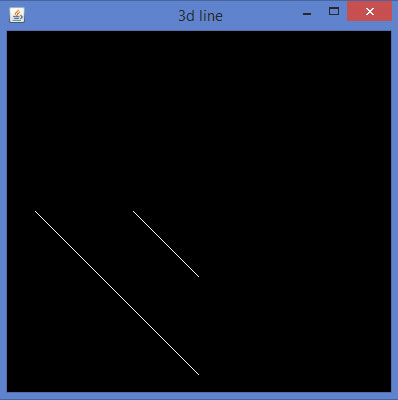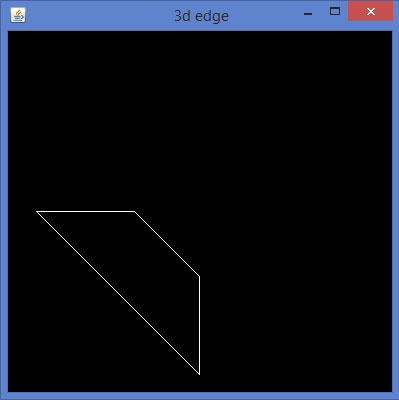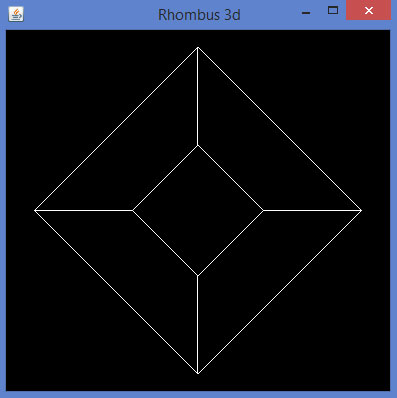In previous chapters we have seen how to create 2d objects, apply
effects to it, and transform the object. This chapter teaches you how to
draw a line with 3rd dimension, and some shapes.
Let us draw a simple line with z-axis and see the difference between 2D and 3D lines. Draw a simple line first, then draw the second line 3 units into the window.
Let us go through the program to draw a 3D line −
 3D shapes can be drawn by giving non-zero values to z quadrant of the glVertex3f() method, which generates the above view. Now joining the remaining lines will lead to a 3D edge.
3D shapes can be drawn by giving non-zero values to z quadrant of the glVertex3f() method, which generates the above view. Now joining the remaining lines will lead to a 3D edge.
Now in the same way let us develop an edge with 3rd dimension.
 In the same way, by developing 3D edges to corresponding sides of any
2D quadrilateral and joining the adjacent vertices, you can get a 3D
quadrilateral.
In the same way, by developing 3D edges to corresponding sides of any
2D quadrilateral and joining the adjacent vertices, you can get a 3D
quadrilateral.
Below given is a program to draw a rhombus using JOGL.
 The predefined parameters of glBegin() method can be used for drawing 3D shapes.
The predefined parameters of glBegin() method can be used for drawing 3D shapes.
Let us draw a simple line with z-axis and see the difference between 2D and 3D lines. Draw a simple line first, then draw the second line 3 units into the window.
Let us go through the program to draw a 3D line −
import javax.media.opengl.GL2; import javax.media.opengl.GLAutoDrawable; import javax.media.opengl.GLCapabilities; import javax.media.opengl.GLEventListener; import javax.media.opengl.GLProfile; import javax.media.opengl.awt.GLCanvas; import javax.media.opengl.glu.GLU; import javax.swing.JFrame; public class Line3d implements GLEventListener { private GLU glu = new GLU(); @Override public void display( GLAutoDrawable drawable ) { final GL2 gl = drawable.getGL().getGL2(); gl.glTranslatef( 0f, 0f, -2.5f ); gl.glBegin( GL2.GL_LINES ); gl.glVertex3f( -0.75f,0f,0 ); gl.glVertex3f( 0f,-0.75f, 0 ); gl.glEnd(); //3d line gl.glBegin( GL2.GL_LINES ); gl.glVertex3f( -0.75f,0f,3f );// 3 units into the window gl.glVertex3f( 0f,-0.75f,3f ); gl.glEnd(); } @Override public void dispose( GLAutoDrawable arg0 ) { //method body } @Override public void init( GLAutoDrawable arg0 ) { // method body } @Override public void reshape( GLAutoDrawable drawable, int x, int y, int width, int height ) { GL2 gl = drawable.getGL().getGL2(); if( height <= 0 ) height = 1; final float h = ( float ) width / ( float ) height; gl.glViewport( 0, 0, width, height ); gl.glMatrixMode( GL2.GL_PROJECTION ); gl.glLoadIdentity(); glu.gluPerspective( 45.0f, h, 1.0, 20.0 ); gl.glMatrixMode( GL2.GL_MODELVIEW ); gl.glLoadIdentity(); } public static void main( String[] args ) { //getting the capabilities object of GL2 profile final GLProfile profile = GLProfile.get( GLProfile.GL2 ); GLCapabilities capabilities = new GLCapabilities(profile); // The canvas final GLCanvas glcanvas = new GLCanvas( capabilities ); Line3d line3d = new Line3d(); glcanvas.addGLEventListener( line3d ); glcanvas.setSize( 400, 400 ); //creating frame final JFrame frame = new JFrame (" 3d line"); //adding canvas to it frame.getContentPane().add( glcanvas ); frame.setSize(frame.getContentPane().getPreferredSize() ); frame.setVisible( true ); }//end of main }//end of classWhen you compile and execute the above program, the following output is generated −
 3D shapes can be drawn by giving non-zero values to z quadrant of the glVertex3f() method, which generates the above view. Now joining the remaining lines will lead to a 3D edge.
3D shapes can be drawn by giving non-zero values to z quadrant of the glVertex3f() method, which generates the above view. Now joining the remaining lines will lead to a 3D edge.Now in the same way let us develop an edge with 3rd dimension.
import javax.media.opengl.GL2; import javax.media.opengl.GLAutoDrawable; import javax.media.opengl.GLCapabilities; import javax.media.opengl.GLEventListener; import javax.media.opengl.GLProfile; import javax.media.opengl.awt.GLCanvas; import javax.media.opengl.glu.GLU; import javax.swing.JFrame; public class Edge1 implements GLEventListener { private GLU glu = new GLU(); @Override public void display(GLAutoDrawable drawable) { // TODO Auto-generated method stub final GL2 gl = drawable.getGL().getGL2(); gl.glTranslatef(0f, 0f, -2.5f); gl.glBegin(GL2.GL_LINES); gl.glVertex3f(-0.75f,0f,0); gl.glVertex3f(0f,-0.75f, 0); gl.glEnd(); //3d line gl.glBegin(GL2.GL_LINES); //3 units in to the window gl.glVertex3f(-0.75f,0f,3f); gl.glVertex3f(0f,-0.75f,3f); gl.glEnd(); //top gl.glBegin(GL2.GL_LINES); gl.glVertex3f(-0.75f,0f,0); gl.glVertex3f(-0.75f,0f,3f); gl.glEnd(); //bottom gl.glBegin(GL2.GL_LINES); gl.glVertex3f(0f,-0.75f, 0); gl.glVertex3f(0f,-0.75f,3f); gl.glEnd(); } @Override public void dispose(GLAutoDrawable arg0) { //method body } @Override public void init(GLAutoDrawable arg0) { // method body } @Override public void reshape(GLAutoDrawable drawable, int x, int y, int width, int height) { // TODO Auto-generated method stubfinal GL2 gl = drawable.getGL().getGL2(); if(height <= 0) height = 1; final float h = (float) width / (float) height; gl.glViewport(0, 0, width, height); gl.glMatrixMode(GL2.GL_PROJECTION); gl.glLoadIdentity(); glu.gluPerspective(45.0f, h, 1.0, 20.0); gl.glMatrixMode(GL2.GL_MODELVIEW); gl.glLoadIdentity(); } public static void main(String[] args) { //getting the capabilities object of GL2 profile final GLProfile profile = GLProfile.get(GLProfile.GL2); GLCapabilities capabilities = new GLCapabilities(profile); // The canvas final GLCanvas glcanvas = new GLCanvas(capabilities); Edge1 b = new Edge1(); glcanvas.addGLEventListener(b); glcanvas.setSize(400, 400); //creating frame final JFrame frame = new JFrame (" 3d edge"); //adding canvas to it frame.getContentPane().add(glcanvas); frame.setSize(frame.getContentPane().getPreferredSize()); frame.setVisible(true); }//end of main }//end of classWhen you compile and execute the above program, the following output is generated −
 In the same way, by developing 3D edges to corresponding sides of any
2D quadrilateral and joining the adjacent vertices, you can get a 3D
quadrilateral.
In the same way, by developing 3D edges to corresponding sides of any
2D quadrilateral and joining the adjacent vertices, you can get a 3D
quadrilateral.Below given is a program to draw a rhombus using JOGL.
import javax.media.opengl.GL2; import javax.media.opengl.GLAutoDrawable; import javax.media.opengl.GLCapabilities; import javax.media.opengl.GLEventListener; import javax.media.opengl.GLProfile; import javax.media.opengl.awt.GLCanvas; import javax.media.opengl.glu.GLU; import javax.swing.JFrame; public class Rhombus implements GLEventListener { private GLU glu = new GLU(); @Override public void display(GLAutoDrawable drawable) { final GL2 gl = drawable.getGL().getGL2(); gl.glTranslatef(0f, 0f, -2.5f); //drawing edge1..... gl.glBegin(GL2.GL_LINES); gl.glVertex3f(-0.75f,0f,0); gl.glVertex3f(0f,-0.75f, 0); gl.glEnd(); gl.glBegin(GL2.GL_LINES); gl.glVertex3f(-0.75f,0f,3f); // 3 units into the window gl.glVertex3f(0f,-0.75f,3f); gl.glEnd(); //top gl.glBegin(GL2.GL_LINES); gl.glVertex3f(-0.75f,0f,0); gl.glVertex3f(-0.75f,0f,3f); gl.glEnd(); // bottom gl.glBegin(GL2.GL_LINES); gl.glVertex3f(0f,-0.75f, 0); gl.glVertex3f(0f,-0.75f,3f); gl.glEnd(); // edge 2.... gl.glBegin(GL2.GL_LINES); gl.glVertex3f(0f,-0.75f, 0); gl.glVertex3f(0.75f,0f, 0); gl.glEnd(); gl.glBegin(GL2.GL_LINES); gl.glVertex3f(0f,-0.75f, 3f); gl.glVertex3f(0.75f,0f, 3f); gl.glEnd(); gl.glBegin(GL2.GL_LINES); gl.glVertex3f(0f,-0.75f, 0); gl.glVertex3f(0f,-0.75f, 3f); gl.glEnd(); gl.glBegin(GL2.GL_LINES); gl.glVertex3f(0.75f,0f, 0); gl.glVertex3f(0.75f,0f, 3f); gl.glEnd(); //Edge 3............. gl.glBegin(GL2.GL_LINES); gl.glVertex3f( 0.0f,0.75f,0); gl.glVertex3f(-0.75f,0f,0); gl.glEnd(); gl.glBegin(GL2.GL_LINES); gl.glVertex3f( 0.0f,0.75f,3f); gl.glVertex3f(-0.75f,0f,3f); gl.glEnd(); gl.glBegin(GL2.GL_LINES); gl.glVertex3f( 0.0f,0.75f,0); gl.glVertex3f( 0.0f,0.75f,3f); gl.glEnd(); gl.glBegin(GL2.GL_LINES); gl.glVertex3f(-0.75f,0f,0); gl.glVertex3f(-0.75f,0f,3f); gl.glEnd(); //final edge gl.glBegin(GL2.GL_LINES); gl.glVertex3f(0.75f,0f, 0); gl.glVertex3f( 0.0f,0.75f,0); gl.glEnd(); gl.glBegin(GL2.GL_LINES); gl.glVertex3f(0.75f,0f,3f); gl.glVertex3f( 0.0f,0.75f,3f); gl.glEnd(); gl.glBegin(GL2.GL_LINES); gl.glVertex3f(0.75f,0f, 0); gl.glVertex3f(0.75f,0f,3f); gl.glEnd(); gl.glBegin(GL2.GL_LINES); gl.glVertex3f( 0.0f,0.75f,0); gl.glVertex3f( 0.0f,0.75f,3f); gl.glEnd(); } @Override public void dispose(GLAutoDrawable arg0) { //method body } @Override public void init(GLAutoDrawable arg0) { // method body } @Override public void reshape(GLAutoDrawable drawable, int x, int y, int width, int height) { // TODO Auto-generated method stub final GL2 gl = drawable.getGL().getGL2(); if(height lt;= 0) height = 1; final float h = (float) width / (float) height; gl.glViewport(3, 6, width, height); gl.glMatrixMode(GL2.GL_PROJECTION); gl.glLoadIdentity(); glu.gluPerspective(45.0f, h, 1.0, 20.0); gl.glMatrixMode(GL2.GL_MODELVIEW); gl.glLoadIdentity(); } public static void main(String[] args) { //getting the capabilities object of GL2 profile final GLProfile profile = GLProfile.get(GLProfile.GL2); GLCapabilities capabilities = new GLCapabilities(profile); // The canvas final GLCanvas glcanvas = new GLCanvas(capabilities); Rhombus b = new Rhombus(); glcanvas.addGLEventListener(b); glcanvas.setSize(400, 400); //creating frame final JFrame frame = new JFrame (" Rhombus 3d"); //adding canvas to it frame.getContentPane().add(glcanvas); frame.setSize(frame.getContentPane().getPreferredSize()); frame.setVisible(true); }//end of main }//end of classimport javax.media.opengl.GL2;When you compile and execute the above program, the following output is generated. It shows a rhombus drawn using 3D lines.
 The predefined parameters of glBegin() method can be used for drawing 3D shapes.
The predefined parameters of glBegin() method can be used for drawing 3D shapes.
No comments:
Post a Comment